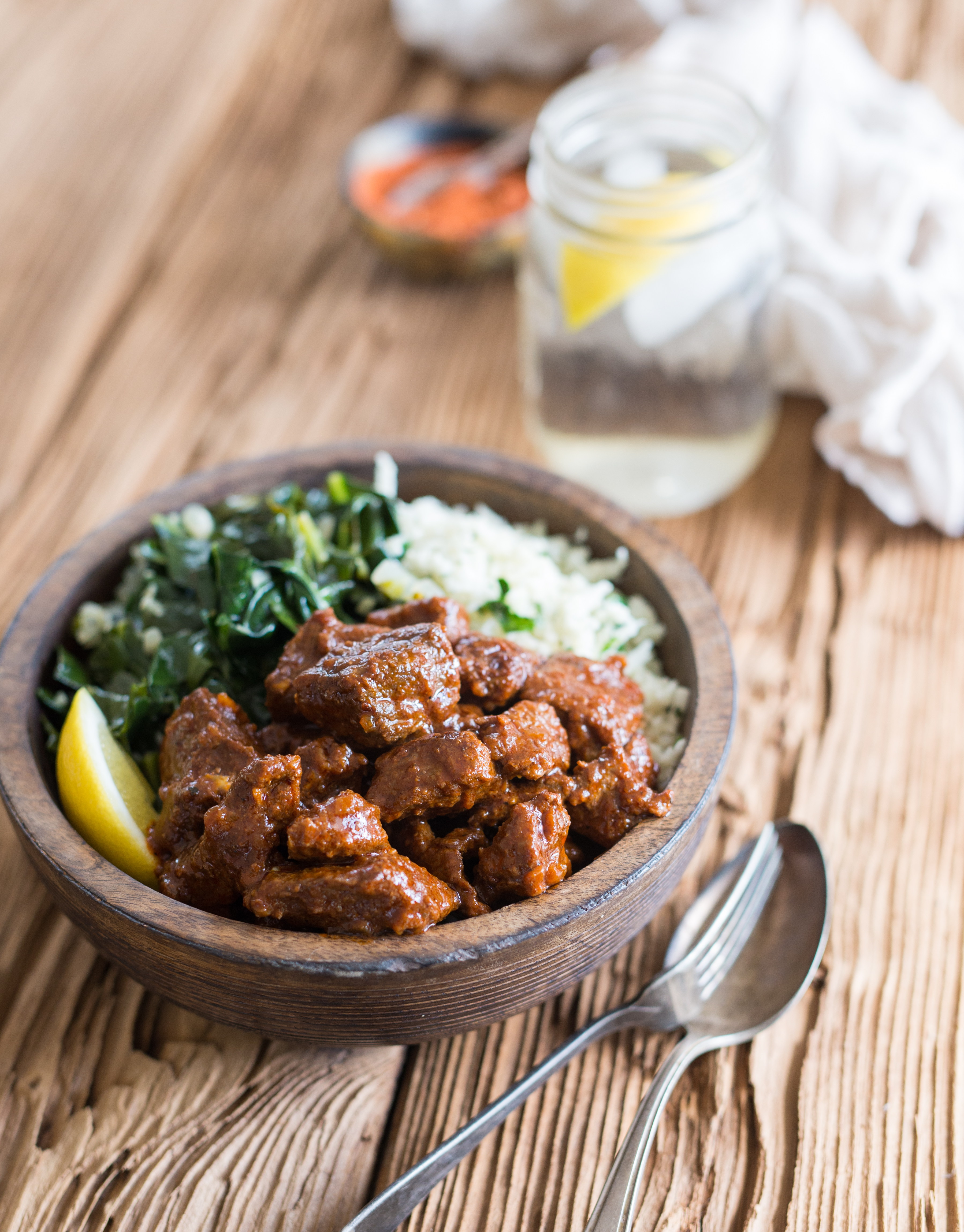In each issue of Paleo Magazine, I team up with Steph Gaudreau to bring you the story of a traditional recipe and adapt it to fit...
Read MoreEthiopian Beef Stew & Collard Greens (Paleo, Whole30)
In each issue of Paleo Magazine, I team up with Steph Gaudreau to bring you the story of a traditional recipe and adapt it to fit into a healthier Paleo lifestyle. (I make the food; she makes the gorgeous photos.) This time, we take your taste buds to Ethiopia for earthy spices and bold flavors.
There is so much to love about Ethiopian cuisine: Eating with your hands! Hearty stews and butter-infused vegetables! Spicy-hot, bright red berbere seasoning! Bread that doubles as a plate! And gursha, an intimate sign of friendship and hospitality.
At a traditional Ethiopian meal, vegetable and meat dishes are served family style, often on an extra-large circle of injera, the spongy, flexible flatbread made from fermented teff flour. (Teff is an ancient, gluten-free grain that’s indigenous to the area.) There’s always a basket of additional injera, so no forks or spoons are needed. Instead, diners tear off a piece of injera with their right hand—always the right hand—and use it to scoop up bites of the main dish before popping it into their mouths. Tear, scoop, eat, repeat. It’s communal, friendly, and relaxed.
In both familiar and formal settings, dinner guests literally feed each other during a meal. An act of respect and love called gursha, it’s common for friends and family to feed others in the group by scooping up a bite of food and placing it in their companion’s mouth: the bigger the bite, the bigger the love. The person receiving a gursha is called the gorash, and the giver is the agurash. (Visit here to see a cartoon of a family sharing gursha.)
Many dishes are seasoned with the spice blend berbere, made from chili peppers, fenugreek, garlic, coriander, ginger, cardamom, cumin, and other spices. Every family has its own carefully guarded secret recipe, and the best berbere is made by roasting whole peppers and spices in the sun, then grinding the ingredients into a fine powder. Another common flavoring is niter kibbeh, clarified butter that’s spiced with fenugreek, cardamom, garlic, and ginger.
The most popular and common dish is wat: meat and vegetable stews, similar to curries. Doro wat (chicken) and key wat (beef) are the ones most frequently found on restaurant menus and family tables, but wat can also be made with lamb (beg wat), chickpeas (shiro wat), or lentils (misir wat). It’s always seasoned with berbere and served with injera, and the richness of the stew is often contrasted with fresh vegetables like gomen (stewed greens).
Rather than ending with a sweet pastry or other dessert, Ethiopian meals usually come to a close with buna (coffee). The coffee ceremony begins with the roasting and grinding of the beans in view of the guests, then the coffee is boiled in a clay pot called a jebena. It’s served in small espresso-style cups with sugar, sometimes salt, and even a dollop of niter kibbeh (the original butter coffee).
For this paleo-friendly Ethiopian-style feast, we’ve selected key wat and gomen, but have replaced the traditional injera with cauliflower rice. Homemade berbere seasoning allows you to control the level of heat, but you can replace the spices in key wat with store-bought berbere, if you prefer. Serve both dishes family style, and feel free to share a little gursha with your favorite people.
Ethiopian Beef Stew (Key Wat)
Serves 4-6 | Prep: 10 minutes | Cook: 90 minutes | Whole30 compliant
Ingredients:
Berbere Seasoning
2 tablespoons paprika
1 tablespoon cayenne pepper
1 teaspoon ground fenugreek
1 teaspoon ground coriander
1 teaspoon ginger powder
1 teaspoon onion powder
3/4 teaspoon ground cardamom
1/2 teaspoon ground cumin
1/2 teaspoon ground black pepper
1/2 teaspoon garlic powder
1/2 teaspoon ground cloves
1/2 teaspoon ground cinnamon
1/4 teaspoon ground allspice
1/4 teaspoon ground turmeric
1/4 teaspoon ground nutmeg
NOTE: You can adjust the amount of cayenne to control the heat of your berbere seasoning. If blazing hot isn’t your thing, reduce the cayenne to 1 teaspoon.
Beef Stew
2 pounds beef chuck, cut into 1-inch cubes
2 tablespoons ghee or extra virgin olive oil
1 1/2 teaspoons salt
1/2 teaspoon ground black pepper
1 small onion, finely diced
3 cloves garlic, peeled and minced
1-2 tablespoons berbere seasoning
1/4 cup tomato paste
1 teaspoon coconut sugar (omit for Whole30)
4 cups beef or chicken bone broth (or a combo)
Directions:
Mix the berbere seasoning. Combine all the spices in a jar, stir with a fork, and set aside.
Brown the beef. Heat the ghee or oil in a large Dutch or soup pot oven over medium-high heat. Season the beef with the salt and pepper, then brown the beef in batches, removing the chunks to a plate as the brown.
Cook the aromatics. Reduce the heat to medium-low, add a little more fat to the pan, if necessary, and add the onions. Cook until golden and translucent, about 12-15 minutes. Add the garlic and cook until fragrant, 30 seconds, then add the tomato paste, berbere seasoning, and sugar. Cook until a thick paste forms, about 3 minutes. Add the broth and beef cubes to the pot, and bring to a simmer. Cook, covered, for 60-75 minutes, or until the beef is very tender.
Big finish. Remove the beef from the cooking liquid and shred it with two forks, then return it to the pot and simmer, uncovered, 15 minutes. Serve with the collard greens. (Cauliflower rice is a nice go-along, too!)
Ethiopian Collard Greens (Ye’abesha Gomen)
Serves 4 | Prep: 10 minutes | Cook: 90 minutes | Whole30 compliant
Ingredients:
2 tablespoons ghee
1/8 teaspoon black cardamom seeds
1/8 teaspoon ground fenugreek
1/8 teaspoon nigella seeds*
2 tablespoons extra-virgin olive oil
1 large yellow onion, minced
3 cloves garlic, minced
2 Thai chiles, stemmed, seeded, and minced (or 1 jalapeño)
1-inch piece ginger, peeled and minced
1 1/2 pounds collard greens, stemmed and cut crosswise into 1/2-inch-wide strips
1 1/2 cups water
1/2 teaspoon salt
1/4 teaspoon ground black pepper
1 lemon
*Nigella seeds—black and triangular in shape—have a slightly nutty taste that’s reminiscent of cracked black pepper. If you can’t find nigella seeds, you may substitute whole cumin or caraway seeds instead.
Directions:
Bloom the spices. Heat the ghee in a large pot over medium heat. Add the cardamom, fenugreek, and nigella and cook, stirring often, until fragrant, 1–2 minutes.
Cook the aromatics. Increase the heat to medium-high and add the olive oil; add onions and cook, stirring often, until browned and soft, 10 minutes. Add garlic, chiles, and ginger and cook, stirring frequently, 3 minutes.
Finish the greens. Add the collards, water, salt, and pepper. Bring to a boil, then reduce heat to low and cook, stirring occasionally, until the collards are tender, 50–55 minutes. Stir in the juice of the lemon and serve hot.
Tastes Great With…
Cook a batch of cauliflower rice to soak up the delicious sauce from the stew. You could go plain, fancy, or lemony.
Still hungry? Try these
In each issue of Paleo Magazine, I share the story of a traditional recipe and adapt it to fit into a healthier paleo lifestyle. In the...
Read More





Thank you so much for posting this recipe! I just made this and can’t keep my hands off it. Thank you!
That’s awesome! I’m glad you enjoyed it!
Any chance this would be ok in an Instant Pot?
I can’t think of any reason why not. You might need to adapt the recipe a bit:
https://www.platejoy.com/blog/how-to-adapt-recipes-for-instant-pot
Made this tonight… it was AMAZING!!!
So glad you enjoyed it!
My local Whole Foods doesn’t carry fenugreek, but it does carry berbere seasoning blend. Would that work? And if so, how much? It looks like the total spice adds up to about 11 tsp. That seems like a ton… would that be right?
Re: fenugreek. If you want to make the berbere seasoning from scratch, you can make it without the fenugreek, and it will still taste great. I don’t really like fenugreek, so I usually skip it.
Re: commercial berbere seasoning. If you decided to buy berbere — which is a totally reasonable option — start with 2-3 tablespoons (that’s the equivalent of 6-9 teaspoons). Most recipes call for 1/4 cup commercial berbere; that’s 4 tablespoons. But if this is your first time making it, it’s better to err on the side of less spicy.
The reason I usually recommend making the berbere from scratch is because you can keep all the non-hot spices and adjust the cayenne to your liking so that it’s flavorful but not scorchingly hot, if that’s not your thing. When you use commercial berbere and cut back on the amount, you not only reduce the heat, but the other spices as well.
Hope this helps!
Thanks!
ACK!!! I went to the FANCY spice store to get everything, and I got ground cardamom instead of seeds. It was a million dollars. Will that work?
Don’t ACK! You bought the right thing 🙂 That’s my bad — the recipe should say ground cardamom. Proceed! And let me know how you like it. (I hope you love it after all of this 🙂
This was worth the wait… I really love the flavor profile! I found that the beef wasn’t tender after 75 mins, though. And it was very soupy. So, I took the lid off the pot and let it go another 45-60 mins. I generally cook my beef stews for 5-6 hrs, so I think I’m just used to that. Also, I think my chicken stock was a salty batch. I never measure when I make stock, so that happens for me sometimes. But, I have the rest of the jar of seasoning I mixed up, and I think I’ll use it again! I’m lucky… I have local Penzey’s retail stores.
Right on! I’m so glad this Ethiopian Stew quest had a happy ending! And yes, Penzeys is the BEST. We had a store near us in Austin, and it was so much fun to pop in there and sniff all the spices. I especially love Penzeys right now because they’re spending their money so wisely. Just a great company, all around.
First time cooking collard greens…How do you get the greens to look so bright? Mine came out a darker, duller green…maybe shorten the cooking time?
I didn’t do this with mine, but I *think* if you add a tiny splash of vinegar to the cooking water, the leaves will stay greener.
I made this tonight, in my instant pot and the collards in a pan on the stove. Absolutely delicious! Love the Berbere spice.
Right on! I’m really glad you enjoyed it! Berbere spice is like magic dust, right?
This was so good! I used red pepper flakes instead of cayenne, since I seem to have used it all up somehow? Anyway, I think I ended up cooking this for about two hours total, which not only made the beef nice and tender but also allowed the sauce to reduce and thicken. Served it over the cauliflower rice, didn’t make the greens since stove space was already at a premium. Next time though (and yes, there will be a next time, especially since I still have plenty of seasoning leftover!).
Anyway, another winner. I don’t think I’ve ever gotten a bad recipe from you! Thanks for providing them!
I’m glad this was a good one for you! Berbere seasoning is a good one to have on hand! You can add zing to just about anything you’re cooking with it. 🙂
Do you think it would taste good to throw the extra spices in a crock pot with some beef? Or do I have to make the whole recipe again?
YES! I call this ‘lazy meat’ at our house — which I do all the time — I don’t make it like stew. I plunk the meat and spices in the slow cooker and no liquid. Let it cook until the meat is fall-apart tender, then heat a skillet really hot, and put the meat in the pan until it’s crispy on the outside. It’s the best of both worlds: tender in the middle, crunchy on the outside.